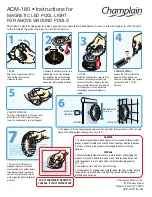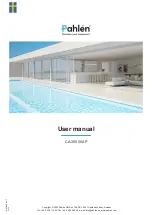
some good practice suggestions that should be
followed.
•
Never use glass containers in the pool area.
•
Choose a location well away from the return
fittings that are bringing water back to the pool.
•
Take the container and turn it upside down to
trap air and then turn the container upright 46
cm (18 in.) below the surface of the water.
Bring container to the surface and cap the
container..
5.6 Salt (NaCI Sodium Chloride)
When to add salt
Add salt to the pool if the salt is too low (see Table
1). For a new pool or newly resurfaced pool it is
recommended to wait at least 30 days (surface
should be completely cured) before adding salt. Do
not run the chlorinator at this time. Manually
chlorinate the pool.
Contact your dealer for recommendations. Follow
the pool surface manufacturer’s guidelines for your
particular pool. For vinyl and fiberglass pools, salt
can be added at start up.
What Type of Salt to Use
•
The purer the salt, the better the life and
performance of the electrolytic cell. Use a salt
that is at least 99.8% pure NaCl. The salt is an
evaporated, granulated, food quality, non-
iodized salt. Consult your pool store.
•
Avoid using salt with anti-caking agents (sodium
ferrocyanide, also known as YPS or yellow
prussiate of soda) that could cause some
discoloration of fittings and surface finishes in
pool.
•
Water conditioning salt pellets are compressed
forms of evaporated salt and may be used but
will take longer to dissolve.
•
Do not
use calcium chloride as a source of salt.
Use sodium chloride only.
•
Do not
use rock salt because insoluble
impurities mixed with the rock salt can shorten
the life of the unit.
How Much Salt to Use
Use salinity test strips, a TDS/salinity meter, or
another reliable method to test the salinity of the pool
water. Once the existing salinity has been
established, use Table 1 to determine the amount of
salt to add to reach the desired level. Be
conservative when adding salt as it is easier to add
more if needed than it is to dilute if there is too much
salt.
•
3,000 ppm of salt is recommended for optimum
water conditions.
•
Low salt concentration below 2,500 ppm will cause
premature cell failure.
•
High salt concentration above 6,000 ppm may cause
corrosion damage to pool fixtures.












































